The ASUS Maximus VIII Extreme Review: The Other $500 Option
by Ian Cutress on April 7, 2016 9:00 AM EST- Posted in
- Motherboards
- Gaming
- Asus
- ROG
- Skylake
- Z170
- Thunderbolt 3
CPU Performance, Short Form
For our motherboard reviews, we use our short form testing method. These tests usually focus on if a motherboard is using MultiCore Turbo (the feature used to have maximum turbo on at all times, giving a frequency advantage), or if there are slight gains to be had from tweaking the firmware. We leave the BIOS settings at default and memory at JEDEC (DDR4-2133 C15) for these tests, making it very easy to see which motherboards have MCT enabled by default.
Video Conversion – Handbrake v0.9.9: link
Handbrake is a media conversion tool that was initially designed to help DVD ISOs and Video CDs into more common video formats. For HandBrake, we take two videos (a 2h20 640x266 DVD rip and a 10min double UHD 3840x4320 animation short) and convert them to x264 format in an MP4 container. Results are given in terms of the frames per second processed, and HandBrake uses as many threads as possible.
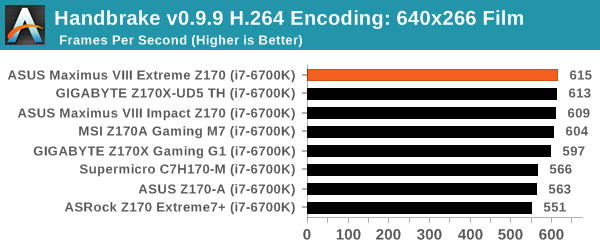
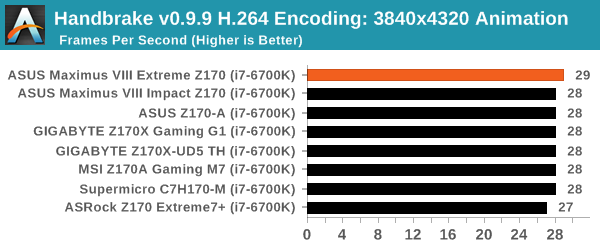
Compression – WinRAR 5.0.1: link
Our WinRAR test from 2013 is updated to the latest version of WinRAR at the start of 2014. We compress a set of 2867 files across 320 folders totaling 1.52 GB in size – 95% of these files are small typical website files, and the rest (90% of the size) are small 30 second 720p videos.
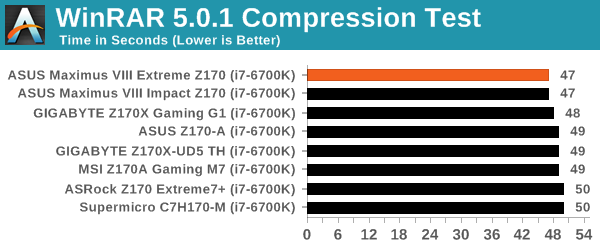
Point Calculations – 3D Movement Algorithm Test: link
3DPM is a self-penned benchmark, taking basic 3D movement algorithms used in Brownian Motion simulations and testing them for speed. High floating point performance, MHz and IPC wins in the single thread version, whereas the multithread version has to handle the threads and loves more cores. For a brief explanation of the platform agnostic coding behind this benchmark, see my forum post here.
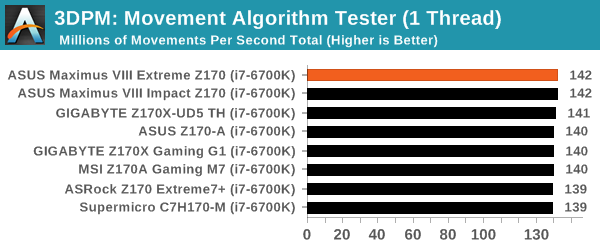

Rendering – POV-Ray 3.7: link
The Persistence of Vision Ray Tracer, or POV-Ray, is a freeware package for as the name suggests, ray tracing. It is a pure renderer, rather than modeling software, but the latest beta version contains a handy benchmark for stressing all processing threads on a platform. We have been using this test in motherboard reviews to test memory stability at various CPU speeds to good effect – if it passes the test, the IMC in the CPU is stable for a given CPU speed. As a CPU test, it runs for approximately 2-3 minutes on high end platforms.
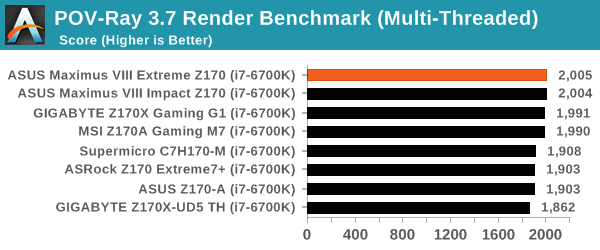
Synthetic – 7-Zip 9.2: link
As an open source compression tool, 7-Zip is a popular tool for making sets of files easier to handle and transfer. The software offers up its own benchmark, to which we report the result.
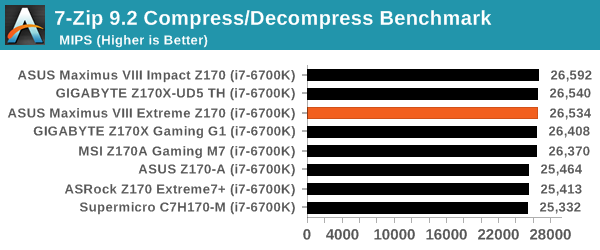










70 Comments
View All Comments
romrunning - Thursday, April 7, 2016 - link
Yes - Thunderbolt3Jon Tseng - Thursday, April 7, 2016 - link
Do these sort of mobos have particularly high end audio integrated? I could see an argument for paying more if you e.g. replaced a $100+ high end audio card.Ditto I guess for the wifi, given a lot of mobos don't seem to have this build in (something I never quite understood why).
arayoflight - Thursday, April 7, 2016 - link
The Z170 deluxe has the same 3x3 MiMo WiFi ac built in and costs much less. I don't think there are 3x3 MiMo cards you can buy. The best I could find was the 2x2 intel one for around 70$.Don't know about sound quality, but it should be good.
extide - Thursday, April 7, 2016 - link
You could read the review, but yes, they have pretty good onboard audio.saratoga4 - Thursday, April 7, 2016 - link
I really wish Anandtech would test the headphone out with maybe 32 ohm headphones rather than just the line out. I'd gladly pay extra for a board with good headphone out, but right now it is almost impossible to know which manufacturers are skimping and which are providing a quality output.DominionSeraph - Friday, April 8, 2016 - link
You can get an Audigy FX for $28. $25 from AmazonWarehouseDeals. (price goes up and down a tad -- I got mine for $22)The ALC898 it uses is no slouch.
extide - Friday, April 8, 2016 - link
That would be a downgrade.jptech7 - Friday, April 8, 2016 - link
For someone wanting better headphone out performance than a high end motherboard, I would not recommend an Audigy FX. The ALC 898 is a downgrade from either the Sabre in this Asus or the ALC1150 found on most good mobos, and for that price, I doubt its ability to drive high end headphones.The included Sabre chip on this Asus board is a quality component, but there are still likely some limitations to integrated audio solutions. For the few people desiring greater performance on their headphone out line, a USB or TOSLINK based dedicated headphone DAC & amp can be had. Decent ones start around $100 and scale up from there.
I would expect the only reason to buy additional equipment in this case would be if you need to provide greater than 2V RMS that the Sabre line driver can provide which is already quite decent.
DominionSeraph - Friday, April 8, 2016 - link
He didn't say he wanted more than a $500 motherboard, he said he wanted to know the performance. I pointed out that the performance is pretty meaningless since the Audigy FX exists. Why would you spend $500 on a motherboard when you can grab a $120 one and throw a $25 card in there that will not only be an upgrade over the ALC892 (or worse) that it will have, but has a headphone driver as well.There will be no discernible difference between an ALC898 and a 1150.
Murloc - Thursday, April 7, 2016 - link
if you care about audio you're exiting it on hdmi anyway, so it'd be a waste of money.